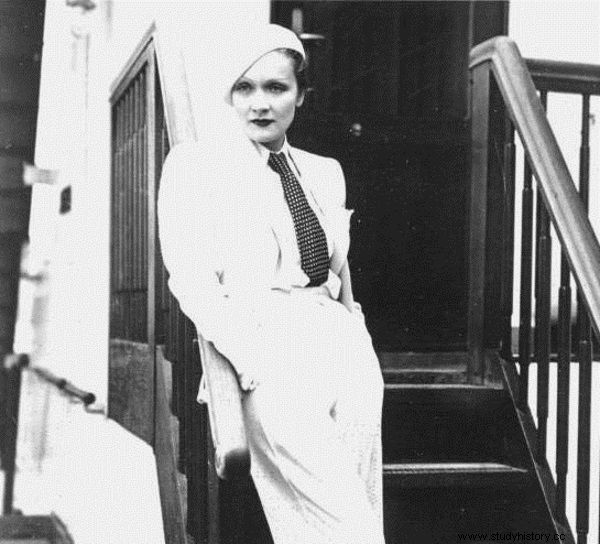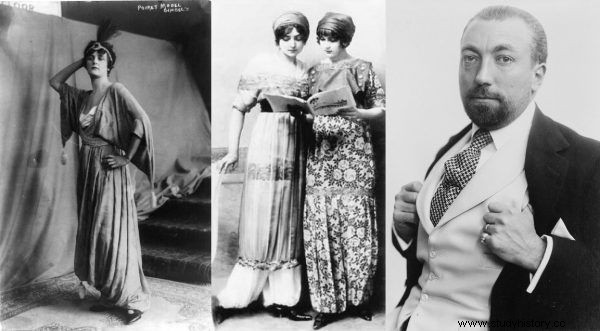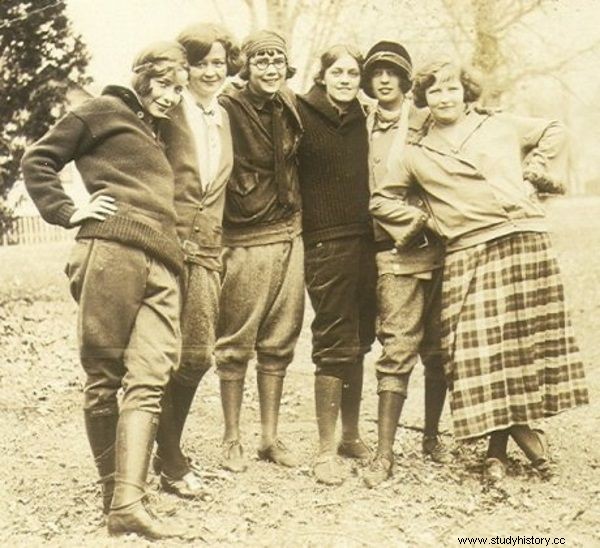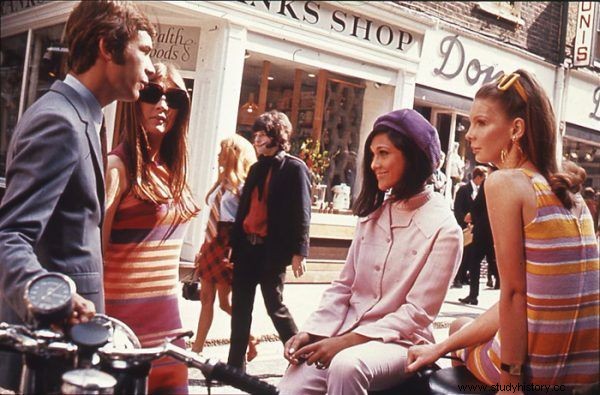For centuries, women's fashion has had little to do with usability. No wonder then that the fight for emancipation was also a fight for the right to ... comfortable clothes. For Polish women, the fight for two legs took several decades. When did they finally win?
Even the Bible seemed to be against women when it came to wearing pants. “A woman will not wear a man's dress, nor a man's dress; for whoever does this is detestable to the Lord his God "- proclaimed the Book of Deuteronomy.
It is therefore not surprising that in Christian Europe, the introduction of elements of men's clothing into women's wardrobes aroused strong resistance. In France, as early as 1933, there was a ban on women wearing pants. The style icon and ardent advocate of two-legged trousers, Marlena Dietrich, found this out. When she arrived in Paris in her signature jacket, high-waisted trousers, white shirt and tie, she received ... police warning that she could be subject to criminal liability!
Fortunately, it ended with warnings, but this story perfectly shows what elegant women were exposed to, beyond socially tolerated conventions. And yet, when Dietrich was on the Seine, the struggle for comfortable clothes had been going on for at least several dozen years. Also in Poland.
"There is panic, rape and frenzy"
Ladies on the Vistula River did not lag far behind global trends. Already the first attempt to introduce women's trousers to the streets of cities found a group of supporters - although, admittedly, quite a few. These were the designer Paul Poiret before the First World War, inspired by oriental fashion. At the same time, in 1911, the fashion house Drécole i Béchoff presented the so-called "trouser dresses" at the races in Paris .

One of the precursors of wearing trousers was Marlena Dietrich, but few women dared to imitate her.
What was the audience's reaction to the new garment for the fair sex? "The few women who showed up in these dresses on the streets were ridiculed," wrote the historian of Polish fashion, Alina Dziekońska-Kozłowska. Also Karolina Żebrowska, blogger and author of the book “Polish Beauty. A hundred years of fashion and style, ”he emphasizes that the outfits designed by Poiret seemed outrageous. "The appearance of a lady in trousers in a public place was reported by local newspapers," he reports.
“Taking notes” is an understatement, however. Suffice it to quote a fragment of a mocking poem that appeared in 1911 in the satirical magazine "A ... psik":
( ) There was a tumult, screaming and noise
Army five were called to rot,
To save the ovation
A novice in a jupe-culotte.
In the end, the trend for skirt-pants did not catch on either in the West or in Poland . Their various styles appeared on the stage at best. The actresses, including Lucyna Messal, welcomed them with joy. Similarly, the dancers performing more and more popular tango on stage. There was a reason it was called in its time ... "trouser dance".
Elegantki II RP
Interestingly, not much changed in the interwar period in terms of tolerance for two legs. And this even despite the fact that during World War I, women sometimes put on pants - if only for practical reasons.
When peace came, everything returned to the (pre-war) standard - although the style of contemporary fashion icons differed significantly from the standards from before 1914, their wardrobes consisted primarily of various types of skirts and dresses. There was simply no room for pants. As Karolina Żebrowska comments, "it was rather difficult to meet similarly dressed ladies on Polish streets, and the ladies' tailcoat lashed by Marlena appeared in Poland only in an artistic edition". Only very brave elegant women decided to wear a "scandalous" outfit. Another fashion historian, Anna Sieradzka, also explains:
It is necessary to dispel the legend repeated by journalists that women wear trousers as everyday clothing. Yes, Marlena Dietrich paraded in pants and men's suits on the screen and in everyday life, but her example did not find many followers. On the city street, at work, ladies never showed up in pants.

Paul Poiret (right) was one of the first to propose the so-called "trouser dresses" (in the center) or "skirt-pants". At first glance, it was hard to distinguish these designs from ordinary dresses.
The lack of acceptance for an item of clothing borrowed from men is clearly visible, for example, in Janina Suchodolska's guidebook "The art of dressing up", published in 1937. There is a list of clothes for a "young, working, poor person". The author lists a whole range of dresses - winter, elegant, spring ... but there is no room for pants in it.
Trousers from the kitchen
However, while in the interwar period going out in trousers into the street was unthinkable for women, they entered women's wardrobes through the back door from the end of the 19th century. "Pants functioned a bit on the sidelines, rarely appearing in magazines, and if anything, in the context of sunbathing or mountain climbing" - says Żebrowska in the book "Polish Beauty. A hundred years of fashion and style. ”
This change was related to the growing interest of the fair sex in sports activities. The men's garment was just much more comfortable.
Women in pants began to appear, among others, on the ski slopes. And no wonder. Earlier, riding in long skirts, with one stick, not only resembled - as Sieradzka maliciously notices - "witches on a broomstick", but also risked their health . As a result, even the oracle in matters of fashion, Janina Suchodolska, allowed for "ankle-length pants, mostly navy blue".

As early as the 1920s, ladies were wearing trousers, for example for horse riding. Illustrative photo (1924).
Amazons and motorists also decided to make a revolution. They were the first to put on breeches, switching to men's saddles. The second, while driving a car, wore knickers or special overalls with wide legs. The new outfit also caught on in less formal situations, i.e. at home and on the beach. And this is due to ... pajamas. As Cally Blackman writes in his book "100 Years of Fashion":
The pajamas were comfortable and made them lovely to look at the beach. The pants included in the set were the first to be widely recognized as an appropriate element of women's wardrobe (not counting those women wore during the war). Apart from the beach, pajamas served as comfortable home clothes; only later became sleeping attire.
Emancipation
The real breakthrough, which brought women's pants from home to the street, had to wait until the end of the 1950s. Of course, with a break for the war, when this item of clothing was put on for work - and for combat. It was worn by Polish fighters and participants of the Warsaw Uprising.
The final "emancipation" of the pants was the work of the French. They found them an acceptable and elegant part of everyday clothing. At this stage, the legs, previously consistently wide, have become significantly narrower.

In the 1960s, the pants finally got fully accepted. Pictured here is Carnaby Street in London in 1966.
But there was still trouble with wearing the pants "ostentatiously". In Poland, girls could not put them into school until the end of the 1960s . “You could be reprimanded for showing up in pants for the lesson; ignoring the ban again could even result in expulsion from school "- says Żebrowska.
However, these were the last strongholds of resistance. When Saint Laurent designed the first women's suit in 1966, the matter was a foregone conclusion. And the next decade - the 70s - was the time of absolute dominance of trousers.
Bibliography:
- Anna Sieradzka, Fashion in pre-war Poland. Everyday, sports, evening, wedding, children's, underwear , PWN 2013.
- Cally Blackman, 100 Years of Fashion , Arkady 2013.
- History of fashion , ed. Marnie Fogg, Arkady 2016.
- Krzysztof Łoszewski, From skirt to pants. History of men's fashion , Bosz 2014.
- Kate Mulvey, Melissa Richards, The canons of beauty. The changing image of a woman 1890-1990 , Arkady 1998.
- Alina Dziekońska-Kozłowska, Women's fashion of the 20th century , Arkady 2007.
- Karolina Żebrowska, Polish beauty. One hundred years of fashion and style , Horizon 2018 sign.
